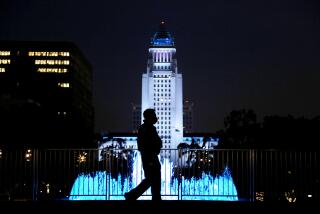Santa Monica Budget Shows Fiscal Health
- Share via
Santa Monica burst forth from its fiscal doldrums this year, and the 1995-96 budget passed by the City Council on Tuesday night offers an even brighter picture for the future.
Though the city’s economic outlook falls short of the abundant 1980s, the $220.7-million budget is $8.7 million, or 4%, higher than last year’s revised budget. The increase is attributable in part to a booming tourist business and the sales and hotel taxes it generates.
The $114-million general fund for city services is up $1.7 million. The additional revenues will be spent on office supplies ($500,000), tree trimming ($380,000) and library materials ($200,000).
Some of it will help fund a 3% across-the-board increase for the social services agencies funded by the city. Their annual grants next year total $6.2 million. Because of the new 100-bed homeless shelter, spending on homeless services will rise $80,000 to $1.7 million for the fiscal year that starts in July.
In addition to revealing the financial health of Santa Monica, the budget discloses the council’s priorities and pet projects.
Next year, the city will spend roughly $1 million on its cable television station--almost half of that for new equipment--despite a drop in ratings.
“It’s an important tool to inform the public,” City Manager John Jalili said.
Other priorities include public safety and city services, social services and $325,000 for arts projects.
Jalili and Finance Director Mike Dennis are most proud of the city’s growing reserves, $10.8 million for this year. The staff squirreled away an additional $7.4 million for a long-needed police station. The money came from $3.4 million in unexpected revenues this year, a onetime lease payment of $2 million and savings in city departments.
Actually, the council offered to put aside $8 million, but on a 4-3 vote, it spent $576,900 of the police building reserves on a variety of projects. They include giving $20,000 to the Santa Monica Museum of Art and adding $25,000 to the lobbying budget to fight changes in the rent control law.
An additional $2,100 was set aside from other accounts so the council could decide later whether to raise--in some cases by $5--the $25 stipend each council member receives for redevelopment, parking and housing authority meetings. Council members earn $50 a month for council meetings, and voters turned down their request for a raise a few years ago.
Among the last-minute budget allocations was $135,000 to promote the Santa Monica Pier--a hefty addition to its $463,000 allocation.
With Mayor Paul Rosenstein leading the way, the four-member majority on the council, backed by the city’s powerful rent control political group, approved the budget.
“This is a moving-forward budget,” Rosenstein said. “I’m proud to support it.”
The other budget supporters were council members Judy Abdo, Ken Genser and Pamela O’Connor.
In protest over what they view as imprudent spending, the three council members not allied with the rent control forces--Ruth Ebner, Asha Greenberg and Robert T. Holbrook--abstained in the budget vote.
An effort by the three to trim about $750,000 in spending failed. They argued against cutting into the money set aside for the police building, which would reduce the size of the bond measure voters will be asked to approve next year.
Culver City, Greenberg noted, built its new City Hall without asking residents to pay more taxes, while in Santa Monica the plan is to ask voters to pay for most of the police building through bonds.
Ebner said Santa Monica’s financial health is no mystery. The city has among the highest utility user taxes and parking fines around, she said. “If you raise taxes when you need more money, you have more money.”
Jalili, however, said the city’s financial health stems from the way it responded to the recession of the last several years. During that period, the city cut 100 staff members, leaving 1,423, and consolidated its departments.
In doing so, Jalili said, the city treated the recession as private business did--as a long-range problem that required drastic action. That’s why Santa Monica is not facing the financial doom of other cities and counties, he said.
Santa Monica is among a handful of California cities--and the only small city--that has the highest bond rating available, which qualifies it to borrow money at a favorable interest rate, Dennis said.
More to Read
Sign up for Essential California
The most important California stories and recommendations in your inbox every morning.
You may occasionally receive promotional content from the Los Angeles Times.










